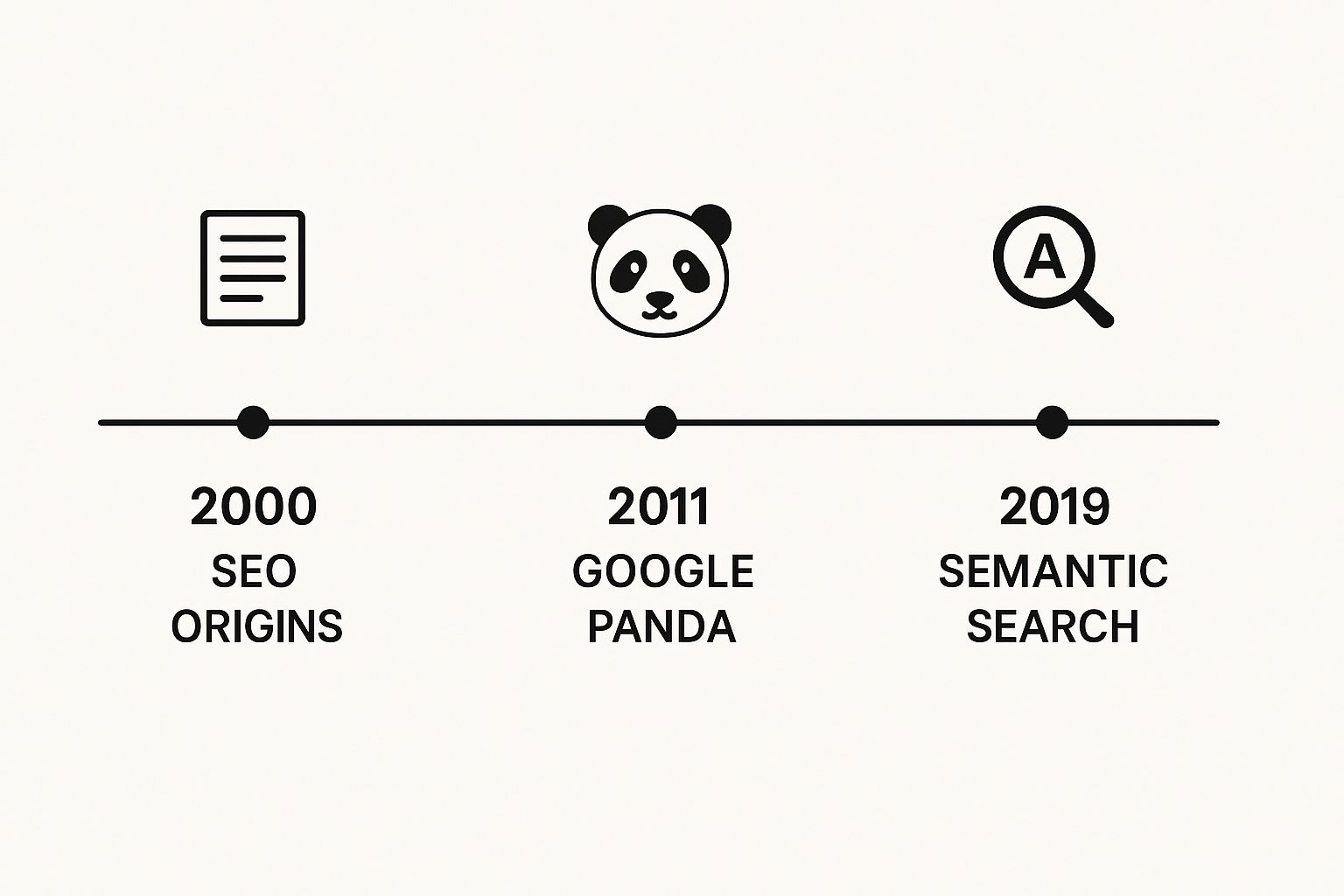Let's get right to it. Keyword density is simply a percentage that shows how many times your main keyword shows up in your content compared to the total word count.
Think of it like adding salt to your favorite dish. If you don't add enough, the meal tastes bland and unfinished. But go overboard, and it's completely inedible. Striking that perfect balance is key, and it’s a fundamental part of creating content that resonates with both people and search engines.
What Is Keyword Density, Really?
At its core, keyword density is just a simple math problem. For a long time, it was a huge deal in on-page SEO. Writers were often told to hit a very specific number of keyword mentions. While SEO has moved on from that rigid approach, knowing the basic calculation is still helpful for understanding where modern strategies came from.
The formula itself couldn't be simpler:
(Number of Keyword Mentions / Total Word Count) x 100 = Keyword Density Percentage
So, if you write a 1,000-word article and use your keyword, "what is keyword density in seo," 10 times, your keyword density is 1%. The math works out as (10 / 1000) x 100.
To make this crystal clear, here’s a quick breakdown of how the numbers work with different content lengths.
Keyword Density Calculation at a Glance
| Total Word Count | Keyword Mentions | Keyword Density Calculation | Resulting Density |
|---|---|---|---|
| 500 | 5 | (5 / 500) x 100 | 1% |
| 1,000 | 15 | (15 / 1000) x 100 | 1.5% |
| 1,500 | 15 | (15 / 1500) x 100 | 1% |
| 2,000 | 40 | (40 / 2000) x 100 | 2% |
As you can see, the final percentage is a direct reflection of how frequently the keyword appears relative to the overall length of the content.
Why Does This Old-School Metric Still Matter?
Knowing this formula helps you understand how early search engines tried to figure out what a page was about. They'd just count the keywords and make a basic call on the topic. It was a crude system, and its flaws quickly became obvious as people learned to game it.
- It was a signal of relevance: Back in the day, repeating a keyword was one of the only ways to tell a search engine, "Hey, this page is about this topic!"
- It was a concrete number: It gave SEOs a clear target to aim for, which made optimization feel more like a science than an art.
- It was easily abused: This simplicity was also its greatest weakness. It led directly to "keyword stuffing," where pages were crammed with keywords to rank higher, making them almost unreadable for actual humans.
Today’s search algorithms are light-years ahead of that simple counting method. Even so, the basic idea of using language to signal relevance is still a central piece of any good search engine optimization strategy. The focus has just shifted from hitting a magic number to using keywords naturally to create the best possible resource for your reader.
How Keyword Density Lost Its Crown
Back in the wild west days of the internet, search engines were pretty simple. To figure out what a webpage was about, they leaned heavily on basic signals, and keyword density was king. For a long time, the SEO playbook was all about hitting a magic number—usually somewhere in the 2-5% range.
This created a predictable, and frankly, awful result: content written for search engine bots, not actual human beings. Pages were clunky, robotic, and crammed with the same phrase over and over again. This whole practice, which we now call keyword stuffing, made for a terrible user experience. Search results were a mess of low-quality pages, and it became clear that search engines needed to get a lot smarter. The reign of simple keyword counting had to end.
This infographic really captures the evolution from those basic keyword metrics to today's much more complex, semantic understanding.

As you can see, the move away from keyword density wasn't just a random change; it was a direct answer to the quality problems that were ruining the search experience for everyone.
The Rise of Smarter Search Engines
Google was at the forefront of this revolution, flipping the script to reward great user experience instead of formulaic tricks. It wasn't one single change but a whole series of game-changing algorithm updates. The focus shifted from "How many times did you say the keyword?" to "How well did you actually cover the topic?"
The Panda update in 2011 was a massive turning point. It specifically went after thin, low-value content—the kind that was often a direct result of keyword stuffing. Then came Hummingbird in 2013, which helped Google understand the context behind conversational searches. More recently, the 2019 BERT update was a huge leap forward, giving Google an almost human-like ability to grasp the nuances of language.
These updates didn't just demote keyword density; they effectively killed the old-school obsession with it.
Today, a page can rank for a keyword without even containing that exact phrase. Modern search engines are far more interested in topical relevance, context, and user intent than they are in how many times a term is repeated.
From Keywords to Concepts
This massive shift forced the entire industry to think more holistically. Modern SEO isn't about hitting an arbitrary percentage anymore. It's about creating a truly comprehensive resource that answers a person's question completely. We've moved from focusing on keywords to focusing on concepts.
So, instead of asking, "What's my keyword density?" the right questions to ask now are:
- Does my content actually solve the problem behind the user's search?
- Am I using synonyms and related concepts to show my expertise on the topic?
- Is my writing natural, engaging, and easy for a real person to read?
This new way of thinking is all about semantic SEO. The goal is to create content that search engines can understand conceptually. When you focus on writing genuinely helpful, well-researched articles, you naturally give the algorithms exactly what they're designed to reward. The crown has officially been passed from keyword density to true content quality.
Calculating Keyword Density the Right Way

While the days of obsessing over hitting a perfect keyword percentage are long behind us, knowing how to calculate it is still a handy skill for any writer or SEO. Think of it less like a rule you have to follow and more like a quick health check for your content. It can help you spot potential problems, like accidentally stuffing your keyword a few too many times or, on the flip side, barely mentioning your main topic at all.
The math itself is actually pretty simple. The formula just turns your keyword count into a percentage of the total text.
(Number of Keyword Mentions / Total Word Count) x 100 = Keyword Density %
So, if your main keyword shows up 15 times in a 1,500-word article, your keyword density is 1%. That’s it. This quick calculation gives you a baseline snapshot of how visible your keyword is in the piece.
A Practical Walkthrough of the Formula
Let’s break this down with a real-world example to see how it works in practice.
Say you just finished writing a 1,200-word blog post on "sustainable gardening tips." You do a quick search and find you’ve used that exact phrase 12 times.
Here’s how the math plays out:
- Count Your Keywords: You mentioned "sustainable gardening tips" 12 times.
- Count Your Total Words: The article is 1,200 words long.
- Apply the Formula: (12 / 1,200) x 100 = 1%
Your keyword density is 1%. Now, this number isn't a pass or fail grade; it’s just a data point. In this case, it suggests your keyword is present and relevant without feeling forced, which is exactly what search engines—and readers—want to see.
Tools to Automate the Process
Let's be honest, manually counting every single word in a long article is a drag and an easy way to make a mistake. Thankfully, you don't have to. There are plenty of free tools out there that can do the heavy lifting for you in seconds.
These tools are perfect for a quick spot-check before you hit publish. Most SEO plugins and online text editors have a keyword density checker built right in. This frees you up to focus on what really matters—writing great content—instead of getting lost in the weeds of manual calculations.
At the end of the day, remember that no major search engine has ever published an "ideal" keyword density. It's a guideline, not a hard-and-fast rule. If you're interested in diving deeper, you can learn more about the technical application of keyword density and how it fits into a modern content strategy.
Recognizing and Avoiding Keyword Stuffing

While getting your main keyword into your content is important for signaling relevance, there’s a line you can cross where it becomes counterproductive. This is where we run into keyword stuffing, an old-school, black-hat tactic that does more harm than good today.
Think of it like this: you're trying to tell Google you’re an expert on a topic, but instead of having a nuanced conversation, you just shout the same word over and over. It's not a good look.
The result is always clunky, unnatural-sounding text that’s a chore to read. Modern search engines are incredibly sophisticated and can spot this kind of manipulation from a mile away. The penalties aren't worth the risk, ranging from a steep drop in rankings to getting your page de-indexed entirely.
What Unnatural Repetition Looks Like
Let's make this crystal clear with an example. Say your target keyword is "blue running shoes."
- Keyword-Stuffed Version: "Looking for the best blue running shoes? Our blue running shoes are the highest quality blue running shoes you can find. For blue running shoes, our shop is the #1 for blue running shoes."
- Natural Version: "Finding the perfect pair of blue running shoes can make all the difference in your workout. We've reviewed top models that offer the support, comfort, and style serious runners need."
See the difference? The first one is a robotic mess that offers zero value. The second one actually helps the reader, which is exactly what Google wants to see.
Actionable Strategies to Prevent Stuffing
Avoiding keyword stuffing doesn't mean you stop using keywords. It just means you use them smarter. The real goal is to build topical relevance, not to hit a magic number.
The core principle is simple: write for your audience first, and optimize for search engines second. When your content is genuinely helpful and easy to read, you naturally create the signals that search engines want to reward.
Here are a few practical ways to keep your writing natural and effective:
- Embrace Synonyms and Variations: Mix it up! Instead of saying "blue running shoes" ten times, use related terms. Think "azure athletic footwear," "navy joggers," or "light blue trainers." This shows Google you have a deep understanding of the topic.
- Use Long-Tail Keywords: Weave in more specific, conversational phrases. People often search for things like "best lightweight blue shoes for marathon running" or "most comfortable navy sneakers for walking."
- Focus on Topical Depth: Don't just stick to your primary keyword. Cover the subject from all angles. Answer common questions, discuss related subtopics, and show you're a true authority. This naturally diversifies your language and builds much stronger relevance signals.
Optimizing Content for Modern SEO
If trying to hit a specific keyword density percentage is a thing of the past, what should you be doing instead? Forget about simply counting keywords. Modern SEO is all about building topical authority.
The goal now is to prove to search engines that you’re a genuine expert on a subject, not just someone who can repeat a key phrase a certain number of times. This shift reflects how search engines have evolved; they now analyze context, synonyms, and related ideas to figure out what your content is truly about. They've moved from repetition to richness.
Understanding Topical Relevance and TF-IDF
A concept that helps explain this shift is Term Frequency-Inverse Document Frequency (TF-IDF). It sounds complicated, but the idea behind it is pretty straightforward. It’s a way to measure how important a word really is to a specific document.
Think of it like this: TF-IDF considers how often you use a term (Term Frequency) but weighs that against how often that same term shows up across the rest of the web (Inverse Document Frequency). If a word appears a lot in your article but is relatively uncommon online, TF-IDF sees it as a strong signal that your content is highly relevant to that specific topic.
This is a much more sophisticated way to gauge relevance. It helps search engines see that an article about "apple pie recipes" that also mentions "cinnamon," "flaky crust," and "baking times" is far more useful than one that just crams the phrase "apple pie recipes" into every other sentence.
Actionable Strategies for Today's SEO
So, how do you optimize for this new reality? You build content that showcases deep knowledge and answers every question a user might have. Before you write a single word, you have to learn how to find the best keywords for SEO that your audience is actually typing into Google. With those core topics in hand, you can put these strategies to work.
Here’s a simple playbook for creating content that search engines will favor:
Weave in LSI Keywords: Latent Semantic Indexing (LSI) keywords are just terms and phrases that are closely related to your main topic. For a page about "what is keyword density in seo," you'd naturally talk about things like "keyword stuffing," "topical relevance," "on-page SEO," and "natural language." Using these terms shows you’re covering the subject from all angles. A good look at keyword research best practices will help you find these gems.
Answer User Questions Head-On: Structure your content to be a complete resource. Use your headings and subheadings to walk the reader through the topic, answering their questions logically. The goal is to make your article the only one they need to read on the subject.
Write Like a Human: In today's SEO, using variations of your keyword and writing naturally is far more important than exact-match repetition. Keyword density can still be a helpful final check to make sure you haven't accidentally overdone it, but it should never be your primary focus. If you're curious, you can read more about the shift to natural language processing in SEO on Seobility.net.
Ultimately, your job is to create the best, most helpful resource for the user. When you focus on delivering real value and covering a topic in-depth, you naturally give search engines all the positive signals they’re looking for.
Your Keyword Density Questions, Answered
Let's be honest, keyword density is one of those SEO topics that just won't die. It’s surrounded by a ton of old advice that can send even seasoned writers in circles. It's time to cut through the noise and get some straight answers.
We'll tackle the most common questions head-on so you can stop worrying about outdated rules and start focusing on what actually moves the needle in modern SEO.
Is There an Ideal Keyword Density Percentage?
No. There’s absolutely no magic number.
The idea that you need to hit a perfect 1% or 2% is a complete myth—a fossil from the early, clunky days of search engines. Chasing a specific percentage is a surefire way to write awkward, robotic content that makes real humans cringe. And that’s the last thing Google wants to show its users.
A much better way to think about it is to just write for your audience.
Focus on creating a genuinely helpful, comprehensive, and easy-to-read piece. When you truly cover a topic, you'll naturally use your main keyword and related phrases the right amount of times.
Think of that old 1-2% range as a guardrail, not a target. If you run a check and see your density is at 5%, that’s a red flag for keyword stuffing. If it’s 0.1%, you might have forgotten to make your topic clear. It’s a tool for a quick diagnosis, not the goal itself.
How Often Should I Check My Keyword Density?
Treat it like a final quality check, not something you obsess over while writing. It's a quick spot-check during the editing phase, not a core part of the creative process. Staring at a density calculator while you write is the fastest way to kill natural flow and creativity.
A quick check makes sense in two situations:
- To Catch Accidental Stuffing: Sometimes you repeat a phrase without even realizing it. A quick density check helps you spot those repetitive sentences so you can rephrase them for better readability.
- To Ensure Topic Clarity: On the flip side, you can get so deep into the weeds explaining related concepts that you barely mention your core topic. A super low score is a good nudge to bring the focus back.
Your priority should always be creating valuable, readable content that covers the topic thoroughly. Checking the density is just a final, minor step to make sure you haven’t gone too far off the rails in either direction.
Do Synonyms and Variations Count Toward Density?
From a purely mathematical perspective, the classic keyword density formula only cares about the exact-match keyword. So if your target is "what is keyword density in seo," terms like "keyword frequency" or "keyword percentage" won't factor into that specific calculation.
But here’s the thing: in modern SEO, that distinction is almost meaningless.
Today's search engines are incredibly sophisticated. Using synonyms, long-tail variations, and related ideas is infinitely more important than just repeating the same keyword again and again.
Google's algorithms, like BERT, are designed to understand context and relationships between words. They know that "keyword stuffing," "on-page SEO," and "topical relevance" are all part of the same neighborhood. Weaving this kind of varied, natural language into your content signals true expertise and depth. A page that does this well will almost always beat one that just hammers an exact-match keyword into the ground.
Ready to stop worrying about old-school metrics and start creating content that actually ranks? At Copy Masters, we handle the entire SEO content process—from in-depth research to expert writing and optimization. We deliver 30 search-optimized articles every month designed to build your authority and drive real business growth. Learn more about our subscription-based service and get a 30-day satisfaction guarantee at https://copymasters.co.
- SaaS SEO Consulting for Predictable Growth - October 20, 2025
- What Is SEO Management Your Guide to Real Results - October 19, 2025
- A Guide to Quality Content for SEO That Ranks - October 18, 2025
